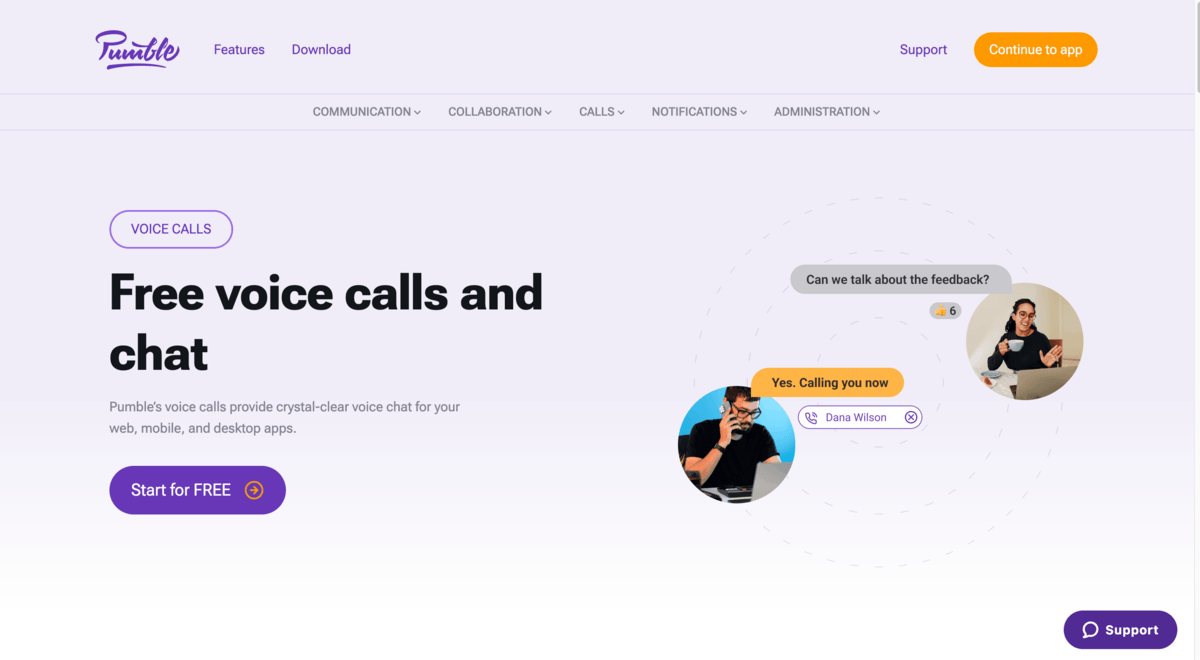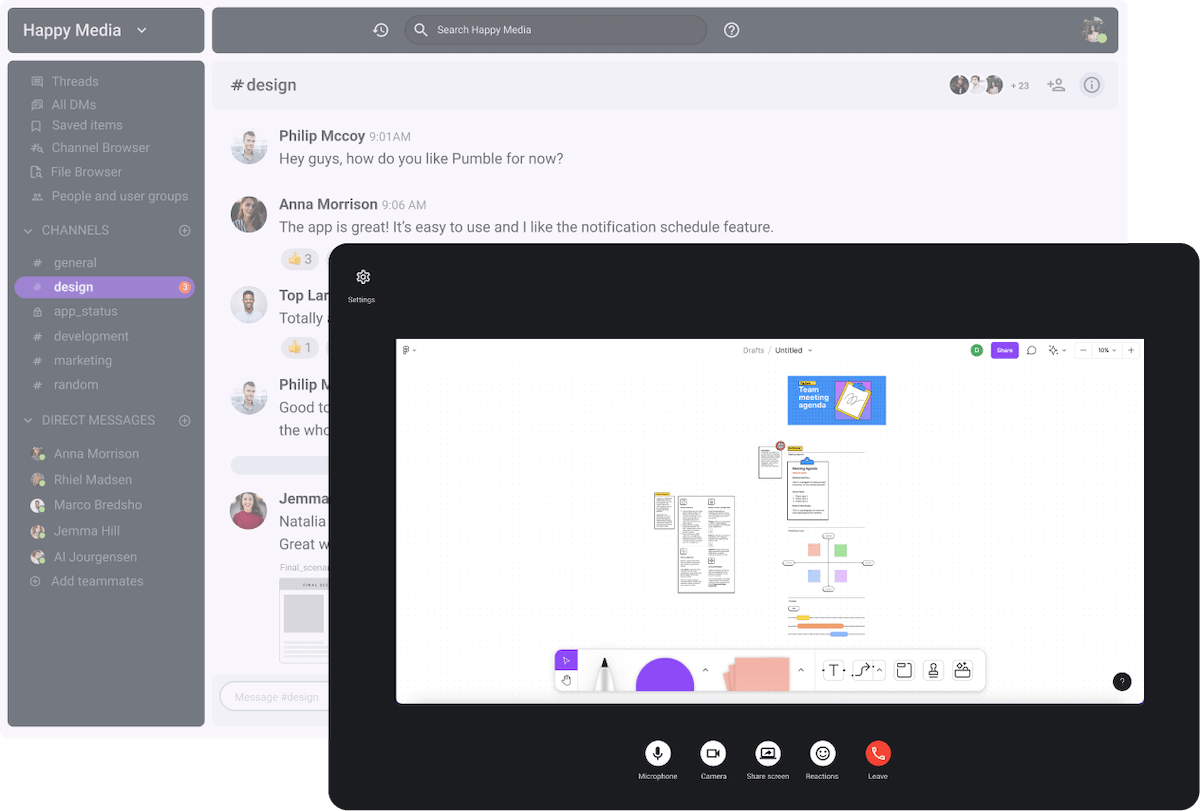They say good listeners are like trampolines — you bounce your ideas off of them.
Namely, attentive listeners are not supposed to simply absorb the speaker’s words, like sponges, but rather reflect them, to deepen their understanding of what’s being said.
So, be honest: are you a sponge or a trampoline?
Whatever your answer may be, the truth is, even the best listeners among us could use some improvement.
To put it another way, we should all strive for deep listening.
If you’re confused, don’t worry — in this blog post, we’ll shed some light on this phenomenon.
First, we’ll define deep listening and illustrate it with an example.
Then, we’ll consider its benefits in the workplace.
In the end, we’ll provide you with 7 tips for engaging in deep listening at work.
So, without further ado, let’s all learn how to be trampolines!

Table of Contents
What is deep listening?
Deep listening is a type of listening in which we are fully present and devoted to the person speaking, without trying to control the conversation or judge it. Deep listening takes place when you’re determined to understand the speaker’s perspective.
This means you need to pay close attention to their verbal and nonverbal cues while listening to them.
To be able to do this, you need to suspend your judgment and be willing to receive new information from the speaker.
This special quality of attention poet John Keats called negative capability — “when a man is capable of being in uncertainties, mysteries, doubts without any irritable reaching after fact & reason”.
In other words, while listening to others, we should be open to the unfamiliar and try not to judge or reason.
Furthermore, we should suspend reactive thinking and open ourselves to the unknown.
Deep listening vs active listening
Before we dive deeper into deep listening, let’s consider the difference between deep and active listening, since these terms are often confused or used interchangeably.
The main difference between deep and active listening is the amount of attention we pay to ourselves and the other person.
In their book Active Listening, Carl Rogers and Richard Evans Farson state that active listening is called “active” because of the listener’s definite responsibility.
Namely, the listener doesn’t passively absorb the words the speaker is saying, but actively grasps the facts and feelings the speaker is conveying. That way, the listener is trying to help the speaker with their problems.
By doing so, the listener builds empathetic bonds with the speaker. For example, an active listener nods or paraphrases what the speaker is saying, to show them they are paying attention.
On the other hand, when deep listening is concerned, we are expected to listen to ourselves as much as we listen to the speaker. It is more contemplative than active listening.
Although this sounds paradoxical, this self-reflection enables us to connect with the speaker more deeply and be more empathetic.
Also, when we engage in deep listening, we allow ourselves to be more vulnerable and enable the conversation to lead us to more creative and innovative places.
An example of the difference between active and deep listening
Imagine that you’ve broken your leg, and the doctor is telling you that you need to wear a cast for 4 weeks. Naturally, you’re heartbroken and openly show the doctor how you feel.
A doctor who is an active listener would respond to your concerns in the following way:
“I see, but you need to wear the cast if you want your bone to heal properly.”
The doctor has heard your concerns, but fails to acknowledge your experience in a way a doctor who engages in deep listening might:
“I feel that you’re uncomfortable, and I know everything itches you. You would much rather get rid of the cast and try to keep still on your own. However, the cast is a much more efficient solution to your problem. It will help your broken bone heal more quickly.”
💡 Pumble Pro Tip
If you want to become a more empathetic leader, check out our blog post on building an empathetic leadership style:
An example of deep listening in the workplace
Let’s look at an example of deep listening in the workplace.
George is working as a UX/UI designer in an IT company. Troubled by the inflation, he asked for an early pay raise.
Since his manager Ramani had to turn him down, he is frustrated with her decision and explicitly expresses his dissatisfaction.
Thankfully, Ramani has engaged in deep listening, and her response is:
“I empathize with your frustration with our decision not to increase your salary this month. You believe that you deserve a raise, and I absolutely agree.
I see that you’re disappointed with our response, but please understand that our company’s policy does not allow us to make individual salary increases without first going through the review process.
I understand that you’re experiencing financial difficulties, but rest assured that we will reconsider your request when the pay reviews take place.”
As she is showing an impressive level of empathy and understanding, George, although he didn’t get a raise, feels heard and acknowledged.
Aside from that, Ramani promised him that his request would be reconsidered the next month.
Why is deep listening important in the workplace?
According to the study on the benefits of deep listening, which gathered data from around 18,000 leaders, 46% of the respondents stated they prefer giving practical advice to taking the time to truly understand their employees.
Not surprisingly, 18% of the surveyed said that people frequently mentioned they could be better listeners.
But, why is it so important anyway?
Why should we strive to be better listeners, or even more so — deep listeners?
We offer you a few benefits of deep listening at work.
Benefit #1: Deep listening helps resolve conflicts
Deep listening is closely connected to silence, which can sometimes be more powerful than words.
This silence allows us to slowly digest the speaker’s words and paraphrase them, to check if we’ve understood them correctly.
By paraphrasing the speaker’s words, we save time and are one step closer to resolving conflicts.
Namely, in his book Nonviolent Communication, Marshall B. Rosenberg states that “studies in labor-management negotiations demonstrate that the time required to reach conflict resolution is cut in half when each negotiator agrees, before responding, to accurately repeat what the previous speaker had said.”
So, if you want to reduce the time spent on conflict resolutions by half, you should engage in deep listening.
Benefit #2: Deep listening helps build trust
If you want to build trust among your team members, no matter whether you’re working in-office, remotely, or practicing a hybrid work model, you need to be a good listener.
That means you should:
- Show interest in what your employee is saying,
- Ask open-ended questions, and
- Acknowledge what is being said.
To put it differently, you should engage in deep listening.
Not only will you be perceived as more likable, but you will also build stronger relationships with your employees and help avoid miscommunication.
Our contributor Andrea Flack-Wetherald, a bestselling author, social worker, and teacher of Mindful Improv Thinking™, highlights the importance of deep listening in fostering a sense of belonging in the workplace:

“If we want to build things we’re proud of and cultivate cultures of actual belonging rather than tokenization, deep listening is imperative. Deep listening keeps us from missing out on great ideas. We naturally hold back our best/bravest ideas when we sense disinterest from others in the room, so deep listening is the best way to draw out the very best in each other.”
As you listen to your employees before speaking, you will come up with deeper questions that will help you establish trust and take the conversation to the next level — toward more constructive solutions to problems.
Benefit #3: Deep listening enables better feedback
Since deep listening enables you to understand the perspectives of others, this means that the feedback you give might be of significantly better quality than the feedback of not-so-good listeners.
Although the focus in feedback is on talking, the ability to really hear your colleagues’ problems and empathize with them makes all the difference.
Furthermore, by listening deeply to your employees, you earn the privilege of providing feedback to them.
Benefit #4: Deep listening improves collaboration
For an organization to function well, different teams need to collaborate and communicate effectively.
However, when leaders don’t listen to their employees, collaboration becomes extremely difficult.
Our contributor Anthony Martin, Founder and CEO of Choice Mutual and a member of the Forbes Financial Council, claims something similar:

“When leaders model deep listening, they create a culture of respect and collaboration for the entire organization. Deep listening leads to self-awareness and growth and helps overcome the blockers that stop the work from getting done.
When an entire company practices deep listening, they are much more engaged and productive in their work and feel seen and respected. Taking the time to really listen to employees and co-workers will make your business more collaborative and successful.”
In other words, deep listening is key to effective collaboration.
According to Lindsay Tighe, an inspirational speaker, coach and author of six books on asking better questions, deep listening is one of the most critical ways to make people feel valued, respected, and understood:

“Enabling these positive emotions leads to people feeling more motivated and engaged, and we know that this will create higher levels of productivity and performance. This level of listening also enables deeper and better relationships, which are critical to creating a positive workplace culture.”
So, practicing deep listening is a surefire way to a better collaboration.
Benefit #5: Deep listening is critical for effective leadership in the workplace
All the aforementioned benefits ultimately lead to this conclusion: deep listening is crucial for effective leadership.
Martin shared with us his opinion on the importance of listening for great leadership:

“Great leaders understand that they need to be able to pick up on every part of a conversation, including what’s not being said, and then be able to control and manage their responses helpfully and respectfully.”
Once again, silence can speak volumes — so leaders should learn to listen to it.
💡 Pumble Pro Tip
To find out more about leadership communication, check out our blog post on that topic:
7 Tips for engaging in deep listening in the workplace
Some people are stronger listeners than others. However, that doesn’t mean we can’t all improve our listening skills.
Namely, like any skill, deep listening can be improved.
By the same token, if you don’t practice them enough, your listening skills can degrade.
So, what are the best ways to reclaim the lost art of listening?
Tip #1: Start with active listening
We’ve already mentioned the difference between active and deep listening — it’s in the amount of attention we pay to the speaker and ourselves.
However, this doesn’t mean that deep and active listening are mutually exclusive.
On the contrary, active listening may lead to deep listening.
In active listening, we’re choosing to be fully involved in the conversation and focused on the other person’s words.
Of course, this also means that we need to eliminate all distractions — e.g. we shouldn’t look at our mobile phones.
Sometimes, voice calls make it easier for us to listen to someone because we can focus better on their words and tone of voice.

💡 Pumble Pro Tip
If you want to find out more about one-on-one meetings, here’s a perfect guide for you:
Tip #2: Listen to understand, not to respond
In her study on listening styles, Faye K. Doell distinguishes between two modes of listening:
- Listening to respond, and
- Listening to understand.
Namely, she has found out that the way in which we listen plays an important role in how we understand our relationships with others.
Listening to respond is hearing enough of what the other person has said to be able to respond.
We already mentioned that it’s not easy to fight distractions — no matter whether they are external or internal by nature.
One of the biggest distractions we have to overpower are our own thoughts.
Namely, the speed of thoughts is much higher than the speed of spoken words, which is why we might easily get lost in our thoughts and start devising different strategies to answer the speaker’s words.
Basically, we’re just waiting to respond. By doing this, we fail to grasp a deeper meaning of what the other person is saying.
On the other hand, listening to understand is an active and deliberate form of listening, which requires our undivided attention.
We are not just waiting for our turn in the conversation, but are focusing on the speaker and what they’re communicating — both verbally and nonverbally.
Tip #3: Listen without judgment
When we’re listening to someone talking, we tend to filter their words through our own reality.
By doing so, we compare their opinions to our own and, if we don’t agree with the speaker, we may find it difficult to hold our judgment.
However, deep listening teaches us to withhold our judgment and separate our own feelings and opinions on the topic of the discussion. By doing so, we’re opening ourselves to new ideas.
During our research on this topic, we reached out to Ginelle Krummey, a Licensed Clinical Mental Health Counselor, who shared with us her opinion:

“It’s a radical act to be considering the practice of deep listening in the workplace. The practice includes demonstrating that a person’s need, desire, or critique is valid and understood. It also includes empowering people with opportunities to voice their needs or interests and to follow through on making them real in the business.”
Another contributor of ours, Steve Carleton, a Licensed Clinical Social Worker and the Executive Clinical Director at Gallus Detox, agrees:

“By deeply listening to others, we can gain a more complete picture of their thoughts, feelings, and experiences without judgment. This can help foster open dialogue and collaboration by creating a safe space for everyone to be heard and respected. Additionally, deep listening can help to uncover new insights, solve problems more effectively, and build trusting relationships. Ultimately, deep listening is essential in the workplace for building strong teams that are productive and successful.”
Namely, the goal is to:
- Focus on the speaker,
- Understand their point of view, and
- Authentically connect with them.
That is the best way to gain the other person’s trust.
Tip #4: Be present and attentive
We’re sure you know how to recognize when someone’s not paying attention to what you’re saying.
They have that distant look in their eyes and are maybe nodding their heads in an attempt to show you they’re actually listening. But, you know! They can’t fool you — their absent gaze is telling you the truth.
Well, hate to break it to you, but, people can tell when you’re not paying attention as well — no matter how successfully you might think you’re pretending to be listening.
Good listeners, on the other hand, are attentive and present.
They are able to resist all distractions and truly show that they’re engaged in what you’re saying.
- So, to be able to deeply listen to someone, first, you need to clear your mind of any lingering thoughts.
- Then, you need to minimize distractions from your surroundings. Yes, this also means you should refrain from checking your phone.
- Lastly, focus solely on the speaker — both their words and body language.
Tip #5: Maintain eye contact
Have you heard of the 50/70 rule?
According to this rule, the appropriate eye contact should be 50% of the time while you’re speaking and 70% of the time while you’re listening to others speak.
So, aside from paying attention to the speaker’s body language, you should also mind your own nonverbal cues, including eye contact.
When you maintain eye contact with the speaker, you show them that you’re interested in what they have to say.
Moreover, you’re exuding confidence.
💡 Pumble Pro Tip
Mind you, nonverbal communication cues (including eye contact) have different meanings in different cultures. So, if your work environment is multicultural, don’t miss our guide on cross-cultural communication:
Tip #6: Ask follow-up questions
If you have trouble understanding something, ask the speaker for clarification.
Sounds pretty straightforward, right?
But, do we always ask for explanations, or do we sometimes pretend to have understood something?
If we want to engage in deep listening, we should learn to ask better questions — in this case, follow-up questions.
For instance, you might want to ask for clarification in one of the following ways:
“I just need to check if I understand that correctly. Are you saying that…”
“It seems to me that you want to say that… Am I right?”
“Have I understood correctly that…”
That is a great way to check if the message you received is the message the speaker intended to send.
By asking meaningful questions, you’re on a sure path to honing your deep listening skills.
Tip #7: Don’t interrupt the other person
Although it might seem we’re stating the obvious, it wouldn’t hurt to remind ourselves that we shouldn’t interrupt other people when they’re talking.
By doing so, we are sending a message to the speaker that we don’t really care about what they’re saying.
It is a clear sign that, while your colleague was talking, you were busy thinking about a clever rebuttal instead of listening carefully.
Master the art of deep listening with Pumble
Pumble helps you improve not only your deep listening skills but also your ability to comprehend every message you receive, regardless if it is written or verbal.
Pumble offers video conferencing and audio call features that ensure a clear audio and video experience helping you comprehend every single message received.
Often, it is good to share your screen during video calls for additional clarity, so a screen-sharing option in Pumbe might be the perfect addition.

You can also get back to some old messages or files, in your DMs or channels, thanks to unlimited message history in Pumble.
Finally, if you want more engagement and closer collaboration with outside partners and associates, you can invite them to your Pumble workspace, thanks to the guest access feature.




